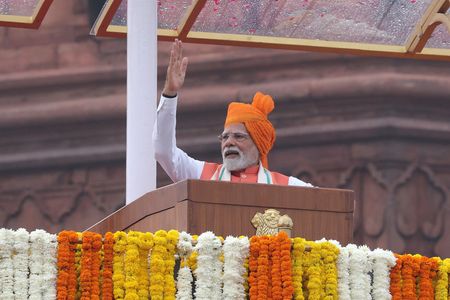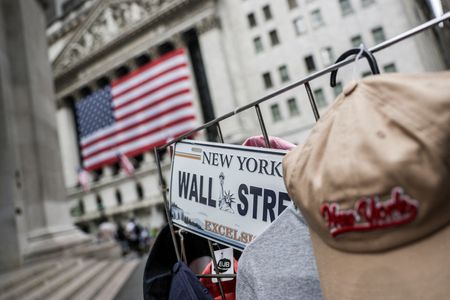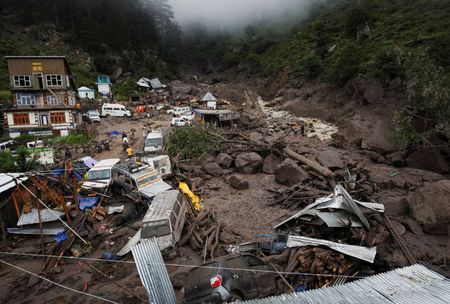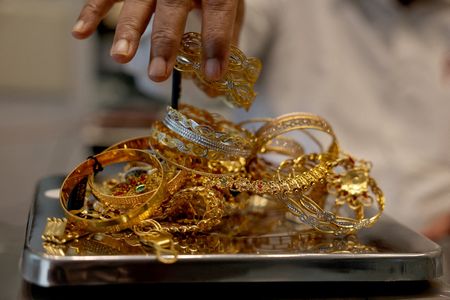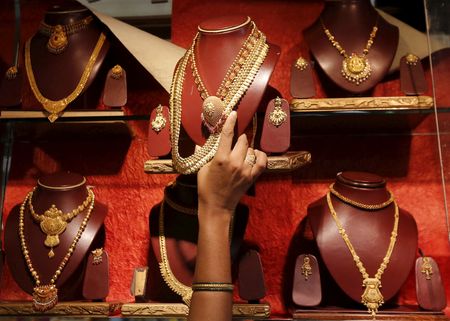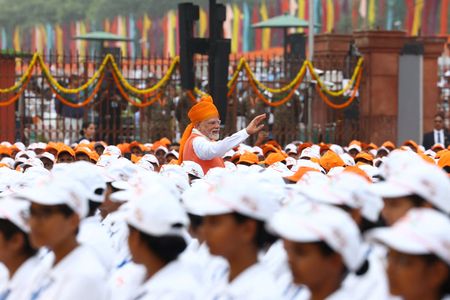By YP Rajesh, Shilpa Jamkhandikar and Nikunj Ohri
NEW DELHI (Reuters) -Indian Prime Minister Narendra Modi urged the country on Friday to move towards more self-reliance, manufacture everything from fertilisers to jet engines and EV batteries, and vowed to protect farmers in the face of a trade conflict with Washington.
With the punishing tariffs imposed on Indian exports by U.S. President Donald Trump expected to hurt growth in the world’s fastest growing major economy, Modi announced lower goods and services taxes (GST) from October – a move that could help boost consumption.
He also announced India would set up a new defence system called ‘Sudarshan Chakra’ in the aftermath of India’s four-day military conflict with Pakistan in May.
He did not elaborate but a government statement said the system is aimed at neutralising enemy infiltrations and enhancing India’s offensive capabilities.
Indian defence and policy circles have informally referred to the Russian S-400 air defence system – which played a key role during the fighting with Pakistan – as Sudarshan Chakra, after a Hindu mythological weapon.
Modi was addressing the nation on the occasion of its Independence Day at a time New Delhi has been struggling with Trump’s tariffs and the collapse of trade talks, largely due to differences over imports of American farm and dairy products.
“Farmers, fishermen, cattle rearers are our top priorities,” Modi said in his customary annual address from the ramparts of the Red Fort in New Delhi.
“Modi will stand like a wall against any policy that threatens their interests. India will never compromise when it comes to protecting the interests of our farmers,” he said.
Modi did not mention the tariffs or the U.S. in his speech that lasted nearly two hours.
Last week, Trump imposed an additional 25% tariff on Indian goods, citing New Delhi’s continued imports of Russian oil in a move that sharply escalated tensions between the two nations.
The new import tax will raise duties on some Indian exports to as high as 50% – among the highest levied on any U.S. trading partner.
Modi has never spoken about the tariffs directly, only alluding to them in a speech last week, where he swore to protect the interests of farmers, even if it came at a personal price.
Farmers are a key political constituency in India and they violently protested against Modi’s last big push to reform the sector, forcing him to repeal three farm laws in 2021 in what was a rare defeat for him.
TAX CUTS TO BOOST CONSUMPTION
Although local manufacturing and self-reliance have been Modi’s key focus areas for years now, the push is seen to have gained urgency amid ongoing global trade tensions and supply chain disruptions.
“The need of the hour is to take a resolve for building a strong India … I want our traders, shopkeepers to display boards for ‘Swadeshi’ products,” Modi said, using the Hindi word for made in India goods.
He said made in India semiconductor chips would hit the market by the end of this year and that India was pushing for self-reliance in producing critical minerals with exploration underway at more than 1,200 locations.
Trump’s tariffs threaten to disrupt India’s access to its largest export market, where shipments totalled nearly $87 billion in 2024, hitting sectors like textiles, footwear, shrimp, gems and jewellery.
In retaliation, some supporters of Modi have sought to stoke anti-American sentiment and called for a boycott of U.S. companies such as McDonald’s, Coca-Cola, Amazon and Apple.
Trade talks between New Delhi and Washington collapsed after five rounds of negotiations over disagreement on opening India’s vast farm and dairy sectors and stopping Russian oil purchases.
Modi’s promise to cut GST by October’s Diwali festival, which encompasses one of India’s biggest shopping seasons, follows previous commitments to overhaul it by reducing the number of rate brackets under the 2017 tax regime.
A group of ministers have been preparing a report that will consider merging tax slabs and lowering rates on some products.
In February, India cut personal income tax for some individuals to boost spending. Earlier this month, the central bank kept interest rates steady, following a 100 basis point cut this year so far.
The government has proposed to the ministers’ panel that it recommend reducing taxes on mass use items as well as on goods used by women, students and farmers to boost consumption and enhance affordability, the finance ministry said in an X post.
The government will move towards making GST a simple tax with two rate slabs, one standard and another merit, it said. Special rates will be applicable only for a few select items.
(Reporting by YP Rajesh, Shilpa Jamkhandikar, Nikunj Ohri and Chandini Monnappa; Editing by Clarence Fernandez and Raju Gopalakrishnan)

